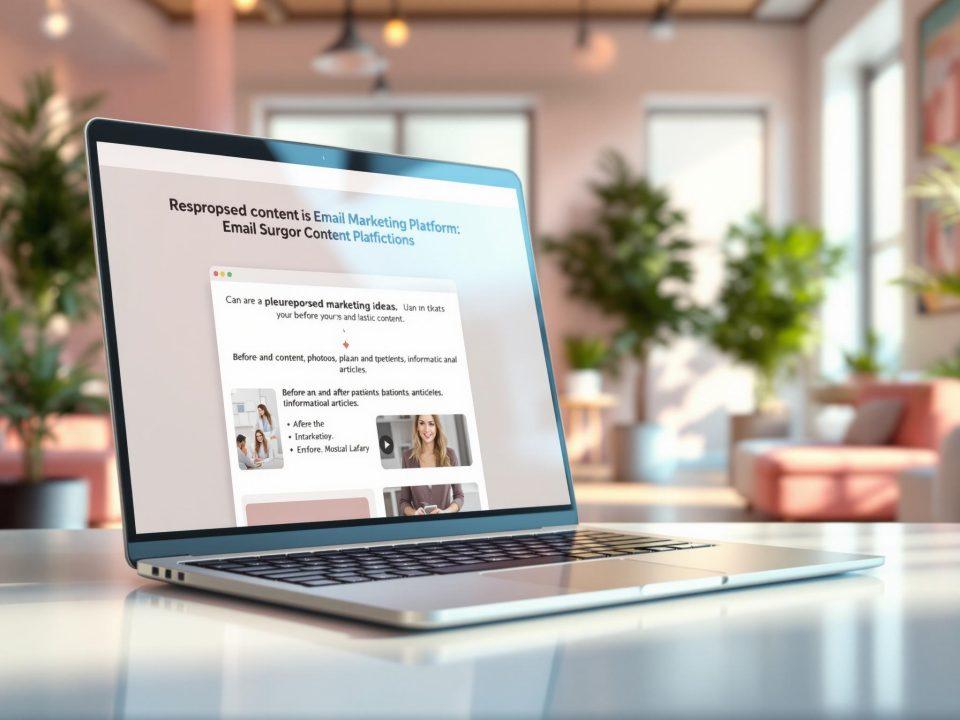How to ride the wave of someone else’s content—and steer potential patients in your direction.
- Create content that patients care about: Answer their questions, show before-and-after photos, and share success stories.
- Boost your local SEO: Use location-specific keywords, optimize your Google Business Profile, and engage with patient reviews.
- Build a fast, mobile-friendly website: Make it easy for visitors to learn about your services and book consultations.
- Analyze competitors: Study their websites, SEO strategies, and content to find opportunities they’re missing.
- Use targeted keywords: Focus on location-based and procedure-specific terms to rank higher in search results.
- Secure quality backlinks: Partner with trusted medical directories, local organizations, and healthcare blogs to improve your site’s authority.
- Track and adjust: Use tools like Google Analytics to monitor traffic, conversions, and engagement, then refine your strategies.
SEO Success Secrets For Med Spas, Dermatologists, Plastic …
Research Your Competition
Understanding your local competition is key to attracting more plastic surgery patients in your area. By analyzing competitors, you can spot opportunities to draw in new patients.
Find Local Competitors
Start by running local searches with phrases like "top cosmetic surgery clinics in [your city]" or "top mommy makeover surgeons in [your city]" [3]. This will help you pinpoint direct competitors. You can also use tools like the Google Ads Transparency Center to see who’s spending on paid ads and what strategies they’re using [3]. Once you’ve identified your competitors, study how they present themselves online to refine your own approach.
Study Their Marketing Approach
Once you know who your competitors are, dig deeper into their marketing efforts. Focus on two key areas:
- Website Analysis: Look at their service offerings, pricing, before-and-after galleries, and whether their site works well on mobile devices [1].
- SEO Performance: Use tools to examine their keyword rankings, website traffic, content strategies, backlink profiles, and domain authority.
Spot Market Opportunities
After reviewing your competitors’ strategies, look for areas where they fall short. These gaps can help you stand out and attract their patients. Consider the following:
- Content Gaps: Are they missing procedure details, FAQs, before-and-after galleries, or educational resources?
- Service Opportunities: Are there procedures they don’t offer, areas with fewer competitors, or patient demographics they’re ignoring?
- Digital Presence: Check if their site is mobile-friendly, if they’re using video content effectively, and whether their local listings are well-maintained.
Build Your Keyword Strategy
Using the insights from your competitor analysis, create a targeted keyword strategy. By identifying gaps in your competitors’ approach, you can attract their potential patients. For instance, there are over 1.25 million monthly searches in the U.S. for plastic surgeons [4]. This presents a big opportunity to drive traffic to your site.
Select Target Keywords
Choosing the right keywords is key to bringing in qualified leads. Focus on location-specific terms that your potential patients are likely to search for. For example, in Dallas, TX, Dr. Jane Smith boosted her website traffic by 45% and patient inquiries by 28% in Q3 2023 by targeting terms like "best rhinoplasty surgeon Dallas" and "tummy tuck cost Dallas" [1].
Here’s how to prioritize your keywords:
- Location-specific terms: Combine procedure names with your city or region.
- Long-tail keywords: Use detailed phrases like "mommy makeover cost in [city]" or "best facelift surgeon near me."
- Procedure-focused keywords: Include specific treatments and their variations.
Once you’ve identified your keywords, create content that speaks directly to your patients’ concerns and interests.
Write Patient-Focused Content
Your content should resonate with potential patients while naturally including your keywords. Here’s how to make it effective:
- Develop service pages that address common patient questions.
- Use before-and-after galleries with optimized image names and alt text.
- Offer educational content about procedures, recovery times, and results.
- Highlight patient success stories to build trust and credibility.
This approach not only helps with SEO but also ensures your content is useful and engaging.
Improve Local Search Rankings
To strengthen your local presence, optimize your Google Business Profile with keywords like "plastic surgeon in [your city]" [1].
Steps to optimize your profile:
- Ensure accuracy: Provide correct contact details, hours, and services.
- Engage with reviews: Collect and respond to patient feedback.
- Post updates regularly: Share news about new procedures or promotions.
- Add high-quality photos: Include images of your facility and team.
"By optimizing your website with the Top SEO keywords for plastic surgeons you are providing yourself with inbound leads that will only serve to complement the ones you generate through referrals and traditional advertising methods." – MarketKeep [4]
This strategy isn’t just about improving rankings – it’s about connecting with people actively searching for your services. Focus on creating content that meets their needs while naturally integrating your keywords.
Create High-Converting Pages
Once you’ve nailed down your keyword strategy, it’s time to build landing pages that stand out and attract patients away from competitors. Did you know almost 90% of website visitors leave without sharing their contact details? [2] Use these tips to create pages that connect with your local SEO efforts and keep visitors engaged.
Key Elements for Your Pages
Your landing pages must grab attention within the first 3 seconds [2]. Here’s what you’ll need to make that happen:
Showcase Patient Success
- Include Before & After galleries with descriptive, keyword-focused image names.
- Use real photos of your facility and team to build familiarity.
- Highlight genuine patient testimonials in a prominent spot.
Build Trust
- Provide clear procedure descriptions with transparent pricing details.
- Display professional credentials and certifications to showcase expertise.
- Ensure contact information is easy to find.
- Keep NAP (Name, Address, Phone) details consistent across all platforms.
Drive Conversions
- Add consultation request buttons in noticeable areas.
- Use strategically placed opt-in forms.
- Write clear and compelling calls-to-action (CTAs).
Make It Local
To attract local patients, tailor your pages with these strategies:
Service Pages
- Create individual pages for each procedure you offer.
- Naturally weave in location-specific keywords.
- Share pricing details relevant to your area.
- Feature testimonials from local patients to build trust.
| Page Element | Local Optimization Example |
|---|---|
| Title Tag | "Top Rhinoplasty Surgeon in [City] – Dr. [Name]" |
| Meta Description | "Expert rhinoplasty in [City]. Board-certified plastic surgeon specializing in natural-looking results. Schedule your consultation today." |
| H1 Heading | "Expert Rhinoplasty Surgery in [City]" |
| Content | Mention nearby neighborhoods, landmarks, and local medical facilities. |
Test and Refine
Around 60% of visitors are willing to share contact details if they find the information valuable [2]. To improve results, test and tweak these elements:
- Headlines and CTAs
- Placement and length of forms
- Choice of images and their locations
- Page load speed
Keep an eye on these metrics to measure success:
- Time visitors spend on your page
- Form completion rates
- Consultation request conversions
- Bounce rates, broken down by device type
Build Quality Backlinks
Once you’ve created pages that convert effectively, the next step is to strengthen your site’s authority with quality backlinks. These links from trusted sources can improve your search rankings.
Get Trusted Links
Here are some reliable sources to consider:
- Medical Directories: Complete profiles on platforms like Doctors.com, WebMD, RateMDs, and Healthgrades. You can also list your practice in manufacturer directories for branded procedures or join professional medical associations that offer member listings.
- Local Authority: Partner with local medical organizations or chambers of commerce. Sponsor community health events, fundraisers, or even set up scholarship programs for medical students.
- Content Partnerships: Write guest posts for respected healthcare blogs, appear as an expert on medical podcasts, or answer healthcare-related HARO queries.
Comparison of Backlink Sources:
| Source Type | Authority Level | Effort Required | Traffic Potential |
|---|---|---|---|
| Medical Directories | High | Low | Medium |
| Local Organizations | Medium | Medium | High |
| Guest Posts | High | High | High |
| HARO Features | Very High | Medium | Medium |
By focusing on these sources, you can secure valuable backlinks that enhance your site’s authority.
Follow SEO Best Practices
What to Do:
- Target relevant medical and healthcare websites for backlinks.
- Ensure linked content adds value for patients.
- Keep your NAP (Name, Address, Phone number) details consistent across directories.
- Build professional relationships to earn links naturally.
What to Avoid:
- Buying links from link farms.
- Engaging in link exchanges.
- Using automated tools for link-building.
- Creating artificial links through blog networks.
Creating meaningful content that attracts links naturally is the key to long-term success. For instance, Episirus, a company organizing medical conventions, featured a guest post from a Miami plastic surgery practice about facelifts. This not only boosted the practice’s authority but also increased referral traffic.
Focus on building connections within the medical community. Contribute to respected medical publications, attend professional events, and engage with peers. These efforts will not only generate quality backlinks but also position your practice as a trusted authority in plastic surgery.
Measure and Adjust
Traffic hijacking requires ongoing monitoring and data-driven tweaks to get the best ROI and improve patient acquisition strategies.
Track Key Metrics
Use Google Analytics to monitor these important metrics:
| Metric Category | Key Indicators | Target Goals |
|---|---|---|
| Traffic Quality | Bounce Rate, Time on Site, Pages per Session | < 40% Bounce Rate; > 3 min Time on Site |
| Conversion Data | Lead Form Submissions, Call Tracking, Appointment Requests | > 3% Conversion Rate |
| Campaign Performance | Click-Through Rate (CTR), Cost Per Acquisition (CPA) | > 2% CTR; < $200 CPA |
| Engagement | Blog Comments, Social Shares, Return Visits | > 15% Return Visitor Rate |
The Beauty Snap 360 platform stands out for plastic surgery practices, delivering conversion rates up to eight times higher than traditional contact forms [3].
Use these metrics to guide updates to your content and campaigns.
Update Based on Results
Leverage data insights to make targeted changes:
Revamp Your Content:
- Add keyword-rich file names, alt text, and properly sized images to your galleries.
- Create new content that highlights your expertise.
- Use tools like SEO.AI to analyze top-performing plastic surgery practices.
Enhance Campaigns:
- Review competitor ad copy through the Google Ads Transparency Center to refine your approach.
- Use heatmaps to pinpoint and fix user experience (UX) issues.
For example, in March 2023, Spotify worked with Mailchimp to cut its email bounce rate from 12.3% to 2.1% in just 60 days. These efforts boosted email deliverability by 34% and generated an extra $2.3 million in revenue [3].
Conclusion
Attracting patients from competitors requires a smart combination of SEO, content marketing, and consistent performance tracking. By concentrating on these key areas, plastic surgeons can improve their online presence and bring in more patients.
Here are a few elements that can make a big difference:
- Optimize your Google Business Profile: Use location-specific terms like "plastic surgeon in [city]" to improve local search rankings.
- Create helpful content: Address common patient concerns and questions to build trust and engagement.
- Build authority: Secure quality backlinks from trusted medical directories and collaborate with local partners.
- Focus on technical SEO: Ensure your website loads quickly and is mobile-friendly.
Studies show that the top three organic search results get 33% of all clicks [2]. Enhance your website with engaging before-and-after galleries and genuine patient testimonials to increase conversions. Almost 60% of visitors are willing to share their contact details if they find the content useful [2].
Use tools like Google Analytics to monitor key metrics and refine your strategy based on the data. This data-driven approach can help you grow your practice in a competitive market. Implement these strategies to attract more patients and build consistent growth for your practice.







